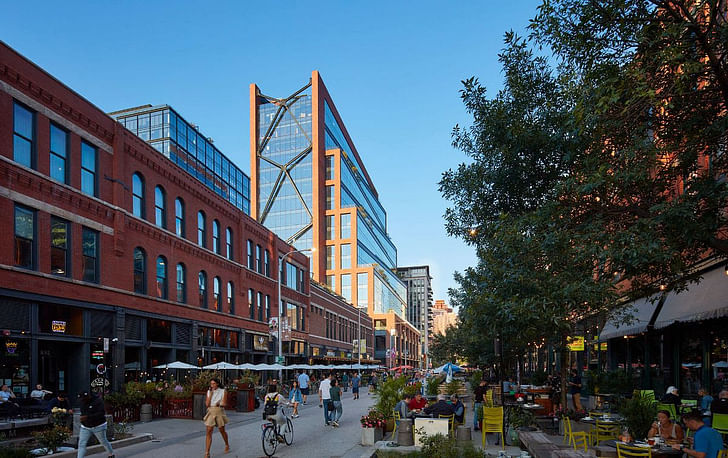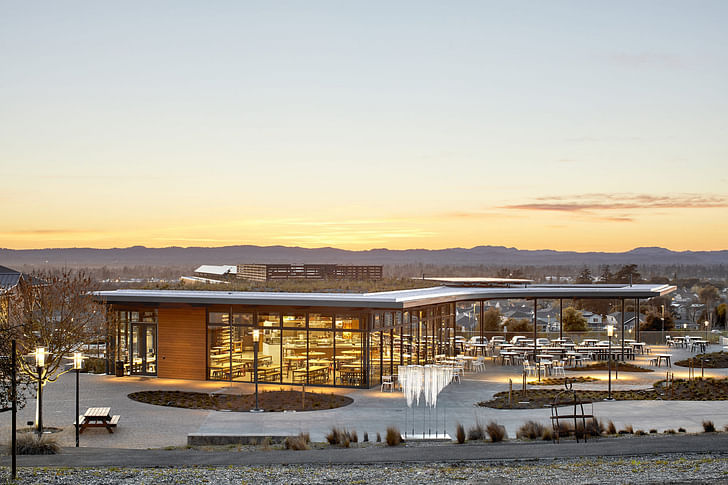

When embarking on a mission to deliver a building to a high environmental and ecological standard, architects are presented with a range of accreditation systems to both guide the design process and reward the results.
While some systems, such as LEED and BREEAM, emphasize environmental and energy performance, others, such as WELL, are preoccupied with occupant health. Meanwhile, programs such as the ILFI's Living Building Challenge span typologies from schools to wineries, while others, such as Passivhaus and NGBS, have their origins in residential design.
To help designers choose which system(s) are appropriate for their projects and to further inform readers on buildings already accredited, we have rounded up six prominent green building labels from across the industry, including examples of accredited buildings previously featured on Archinect.
LEED (Leadership in Energy and Environmental Design) is a points-based rating system developed by the U.S. Green Building Council. The USGBC describes LEED as “the world’s most widely used green building rating system,” counting 197,000 LEED projects across 186 countries and territories.
A project (whether new construction, interior fit-outs, operations and maintenance, or shell and core) achieves LEED certification through earning points based on their adherence to measures that address carbon, energy, water, waste, transportation, materials, health, and indoor environmental quality.
The USGBC describes LEED as the world’s most widely used green building rating system.
Points-based assessments for the project are carried out by Green Business Certification Inc. (GBCI), with the ultimate certification being determined by how many points are scored. The current LEED certification levels in ascending order are Certified (40–49 points), Silver (50–59 points), Gold (60–79 points), and Platinum (80+ points).
Examples of LEED-certified buildings featured on Archinect include Renzo Piano’s Academy Museum of Motion Pictures (LEED Gold), Foster + Partners’ Apple Flagship Store Mumbai (LEED Platinum), and Snøhetta's AIRSIDE Hong Kong (LEED Platinum).

BREEAM (Building Research Establishment Environmental Assessment Method) is a sustainable building assessment system developed in 1990 by the UK’s Building Research Establishment (BRE). BREEAM assesses buildings across several categories, including energy, water, health and well-being, pollution, transport, materials, waste, land use and ecology, and management processes.
Where LEED emphasizes energy efficiency and carbon emission reduction in its points-based system, the BREEAM system involves a broader range of assessment categories, such as ecology and pollution.
Projects are assessed by a licensed BREEAM assessor and awarded a rating based on their scoring performance in the above areas, ranging from Pass (30%+), Good (45%+), Very Good (55%+), Excellent (70%+), to Outstanding (85%+). Where LEED emphasizes energy efficiency and carbon emission reduction in its points-based system, the BREEAM system involves a broader range of assessment categories, such as ecology and pollution.
Examples of BREEAM-certified buildings featured on Archinet include MVRDV’s Matrix ONE (BREEAM Excellent), UNStudio’s Fellenoord 15 (BREEAM Excellent), and Foster + Partners’ Bloomberg European HQ (BREEAM Outstanding).

The WELL Building Standard is a performance-based certification system developed by the International WELL Building Institute (IWBI). Whereas the LEED and BREEAM emphasize a building’s energy and ecological performance, WELL is considered to be more weighted towards the health and well-being of building occupants.
WELL certification assesses a building’s impact on occupants through ten key concepts: Air, Water, Nourishment, Light, Movement, Thermal Comfort, Sound, Materials, Mind, and Community. These concepts are designed to create environments that support physical, mental, and emotional well-being. For instance, the Air concept focuses on improving indoor air quality through ventilation and filtration, while the Nourishment concept encourages access to healthy food options.
Whereas the LEED and BREEAM emphasize a building’s energy and ecological performance, WELL is considered to be more weighted towards the health and well-being of building occupants.
The certification process involves testing and verification by third-party assessors. WELL offers three levels of certification: Silver, Gold, and Platinum, depending on the number of features a building successfully implements.
Examples of buildings targeting or holding WELL certification featured on Archinect include SOM’s 800 Fulton Market (WELL Gold) and 3XN/Arcadis IBI’s Rotman Commerce Building.

The National Green Building Standard (NGBS) is a certification system specifically designed for residential buildings in the United States. Developed by the National Association of Home Builders (NAHB) and approved by the American National Standards Institute (ANSI), NGBS seeks to provide a framework for designing and constructing sustainable dwellings spanning single-family homes, multifamily buildings, and remodeling projects.
NGBS certification assesses buildings across six key categories: Energy Efficiency, Water Efficiency, Resource Efficiency, Resource Efficiency, Lot Development, Operation & Maintenance, and Indoor Environmental Quality. Homes are rated based on a point system within these categories, with certification levels spanning Bronze, Silver, Gold, and Emerald.
NGBS seeks to provide a framework for designing and constructing sustainable dwellings spanning single-family homes, multifamily buildings, and remodeling projects.
NGBS certification is verified through two third-party inspections to ensure compliance with the standard. NGBS further notes that their system is the only residential certification program that “requires increasingly higher point thresholds in ALL categories in order for a home to reach the next level of certification.”
Examples of NGBS-certified buildings featured on Archinect include Stantec’s Solitair Brickell (NGBS Silver).

Passivhaus is a certification standard for energy efficiency in buildings, focused on reducing the energy required for heating and cooling. Developed in Germany in 1996 by the Passivhaus Institute, the standard is applicable to various building types, including residential, commercial, and institutional buildings.
To achieve Passivhaus certification, a building must meet four specific criteria spanning space heating/cooling energy demand limits, renewable primary energy demand limits, airtightness limits, and thermal comfort levels. “All of the above criteria are achieved through intelligent design and implementation of the 5 Passive House principles: thermal bridge-free design, superior windows, ventilation with heat recovery, quality insulation, and airtight construction,” the Passivhaus Institute notes.
Passivhaus is a certification standard for energy efficiency in buildings, focused on reducing the energy required for heating and cooling.
In addition to buildings acquiring Passivhaus certification, planners and designers, including architects, can also become a ‘Certified Passivhaus Designer.’ In the United States, Passive Buildings are overseen by both the Passive House Institute's (PHI) Passive House Network and the Passive House Institute US (Phius).
Examples of certified buildings featured on Archinect include Handel’s Winthrop Center (PHI-certified) and HPZS’ Yannell PHIUS+ House (Phius-certified), while the certification system also formed a plot line for the recent Showtime series The Curse starring Emma Stone and Nathan Fielder.

The International Living Future Institute (ILFI) offers a suite of certifications that focus on creating regenerative, sustainable, and socially responsible buildings, products, and communities. The most prominent certification under ILFI is the Living Building Challenge (LBC). The LBC examines buildings through the lens of sustainability, resilience, and health, with buildings measured through seven performance categories or ‘Petals’: Place, Water, Energy, Health & Happiness, Materials, Equity, and Beauty. The seven petals are themselves comprised of a total of 20 ‘imperatives’ or sub-requirements.
There are three certification options under the LBC: Living Certification, Core Certification, and Petal Certification. A Living Certification is achieved by a project that meets all 20 imperatives, while a Core Certification is achieved by a building that meets 10 ‘core’ imperatives. A Petal Certification is achieved by projects that meet all 10 ‘core’ imperatives in addition to the achieving of all imperatives contained in one or more of the Water, Energy, or Materials Petals.
The LBC examines buildings through the lens of sustainability, resilience, and health with buildings measured through seven performance categories or ‘Petals.’
In addition to the LBC, ILFI oversees other sustainable/holistic certification systems, such as the Living Product Challenge and Living Community Challenge for product and community initiatives, as well as the Core Certification, Zero Energy Certification, and Zero Carbon Certification systems.
Examples of projects either holding or seeking LBC certification on Archinect include BIG and Heatherwick’s Bay View HQ, Piechota Architecture’s Silver Oaks Alexander Valley Winery, and WRNS Studio’s Janet Durgin Guild & Commons.
Niall Patrick Walsh is an architect and journalist, living in Belfast, Ireland. He writes feature articles for Archinect and leads the Archinect In-Depth series. He is also a licensed architect in the UK and Ireland, having previously worked at BDP, one of the largest design + ...
2 Comments
All this word-salad re: sustainability reminds me of the biochemistry world where we still have 5 names for the simplest molecules, processes, and body parts - stooopid ! Get an international pow wow together and UNIFY this stuff !!! or architects look like dummies who can't get their shit together. LEED was first on this block so have all these other frameworks for measuring this climate-change stuff as sub-categories AND get rid of ALL OVERLAP ! Think of the early 20th Century illumination engineers getting together in 1905 and decidiing that red means stop and green means go.
Two things, 'standards' need to be objective. Performance must be measured post-occupancy, otherwise you award gold medals for simulated performance, and the gap between real-world performance and simulated is well known. Also, carbon needs to be highlighted, both lifecycle and operational. Few of these standards even ask you to measure BOTH. https://openbuilding.ca/oaa - for a tool that cuts through all of the BS and looks at measured performance first, and lets you compare standards (Canada-specific for now).
Block this user
Are you sure you want to block this user and hide all related comments throughout the site?
Archinect
This is your first comment on Archinect. Your comment will be visible once approved.